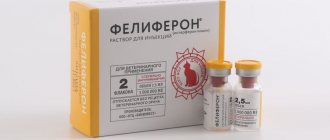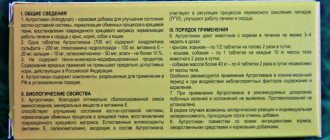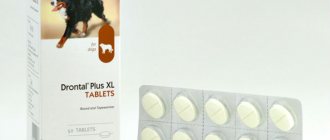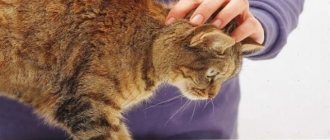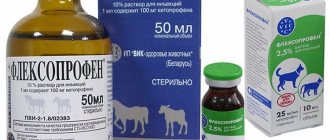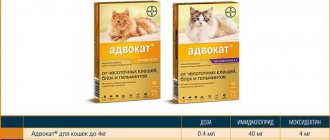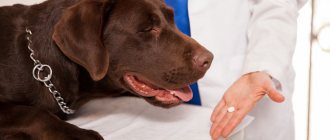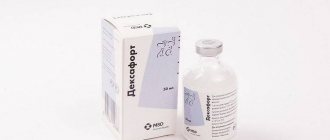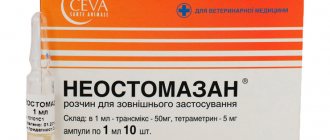Otodectin for cats is a drug that is used to rid an animal of parasites. The product is low-toxic and therefore safe for the health of your pet. In addition, the risk of side effects is minimized. The medication is used sparingly and is relatively inexpensive, which avoids large financial costs.
Composition and release form
The medication is available in the form of an injection solution. The colorless and transparent sterile liquid is packaged in plastic bottles or glass ampoules. The volume can be different - from 1 to 20 ml. When purchasing medicine for cats, choose small-volume packaging, since doses are calculated based on weight.
The main active ingredient is ivermectin, which has a detrimental effect on various types of parasites. The concentration of the substance is small - only 1 mg per 1 ml of solution, which makes the medicine safe for animals.
The composition includes triethylene glycol and isopropanol as additional components.
Indications for use
Otodectin for cats is prescribed for the treatment of the following diseases:
- otodectosis;
- helminthic infestations caused by nematodes;
- demodicosis;
- psoroptosis;
- sarcoptic mange;
- notoedrosis.
The medicine is also used to combat lice or lice-eaters. The appearance of parasites in an animal is usually indicated by apathy, lack of appetite, behavioral changes and other symptoms. Sometimes the disease occurs without visible manifestations, but the parasites poison the animal’s body with their waste products, which leads to severe intoxication and serious health problems. To prevent this, it is necessary to carry out preventive measures and periodic examinations.
Pharmacological properties
According to its pharmacological properties, the antiparasitic agent belongs to the group of macrocyclic lactones. Otodectin for cats (hazard class 4) contains the extremely dangerous component ivermectin (class 1), so it is important to follow the dosages prescribed by your veterinarian.
The main targets of ivermectin are glutamate-sensitive chloride channels and GABA (γ-aminobutyric acid) receptors. The mechanism of action lies in the ability of the active substance to influence the magnitude of the current of chlorine ions. The resulting disturbance in the conduction of nerve impulses causes paralysis and death of the parasite.
Such an effect becomes detrimental not only for sexually mature individuals capable of laying eggs, but also for those that are in the larval stage of development. The spectrum of action of the drug is wide; Clinically proven to be effective against the following parasites in carnivores:
- sarcoptic mites Otodectes cynotis, Sarcoptes vulpis and S. canis, Psoroptes cuniculi, Notoedres cati;
- demodectic mites;
- nematodes Uncinaria stenocephala, Toxocara mistax and T. canis, Ancylostoma caninum, Toxascaris leonina, etc.;
- insects Lmognathus setotus, Ctenocephalides felis and C. canis, Trichodcctes canis.
After administration, ivermectin provides a continuous parasitocidal effect for 2 weeks. The substance is absorbed from the injection site and distributed in organs and tissues. It is excreted from the animal's body with urine and bile, and in lactating animals - with milk.
The drug is toxic to bees and fish, but does not have a teratogenic or toxic effect on the embryo, and no cases of mutagenic effects have been recorded.
Instructions for use
Otodectin injections are administered subcutaneously. Usually injections are given in the forearm area. You can also inject the solution into the area behind the shoulder joint. For administration, use sterile syringes with short needles (no more than 2 cm). It is important to follow the rules of asepsis. The injection site is wiped with medical alcohol, and all manipulations are carried out using rubber gloves.
The dose of the drug is calculated taking into account weight. For every kilogram of weight you need to take 0.2 ml of Otodectin. Drug therapy does not require special preparation or compliance with special instructions.
If the medication is used to get rid of helminthic infestations, the injection is given once. When fighting ectoparasites, it is necessary to use the medicine twice in the doses indicated above at intervals of 8-10 days.
When using an antiparasitic agent to kill fleas or lice, additional treatment of bedding and household items is required. Otherwise, re-infection cannot be ruled out. If parasite infection is accompanied by a bacterial infection, Otodectin is used in combination with antibiotics and other medications.
Purpose
Otodectin, like any medical or veterinary drug, cannot be used for self-medication. The drug is prescribed by a veterinarian for the following types of infestations.
Otodectosis is also known as ear scabies. The microscopic parasite penetrates the cat's ear, makes passages under the skin in the ear canal, and is most active at night. The tick is constantly moving, which causes discomfort in the animal. The insect feeds on pieces of skin, and the mite waste gets into the microscopic wounds that form. There they rot and cause inflammation. Without treatment, the inflammation develops further and can invade the inner parts of the ear and affect the lining of the brain, which will lead to the rapid death of the animal.
Demodicosis is a disease caused by infection with skin parasites - mites that settle on the cat’s body and form microchannels under the skin. The tick's movements throughout the animal's body, as well as its waste products, cause itching, and the pet scratches its body until there are wounds and blood. These wounds serve as open gates for pathogenic bacteria and viruses to enter the body. Advanced infection may be complicated by secondary bacterial infection.
Ticks of the genus Notoedres cati parasitize the skin of pets, but also pose a danger to humans. When a cat is infected, lesions are visible on the body, most often they are localized on the forehead, ears, bridge of the nose, and head. In these places you can observe nodules, blisters, and areas of baldness.
Another type of mite, sarcoptoid mite, causes scabies. Even from the name you can understand that the main manifestation of the disease is severe itching. The cat becomes nervous, a rash appears on its body, and the areas where it was scratched become covered with scales. The appearance of the coat deteriorates, it becomes dull, and bald patches form in areas where it has been scratched.
No less dangerous than ticks and fleas are internal parasites. Settling in the cat’s intestines, they disrupt its microflora and cause inflammation. If the infection is severe, other internal organs may be affected. The waste products of worms cause severe intoxication of the body, and with a large number of parasites there is a risk of intestinal blockage, which will cause the death of the pet.
If you suspect a helminthic infestation or mite infestation, you should take your cat to a veterinarian as soon as possible. Using tests and laboratory tests of skin scrapings (if infected with mites), he will determine the type of causative agent of the disease and select the most effective and safe drug. Along with Otodectin, medications are usually prescribed that will support the functioning of the liver, which is under increased stress due to the massive death of parasites. Vitamin and mineral complexes will help support the immune system.
Contraindications and side effects
According to the GOST classification, the drug is classified as low-hazard, but in some cases it is worth abandoning its use in favor of other drugs. You cannot give injections:
- kittens that have reached 2 months of age;
- weakened animals;
- for infectious diseases.
The instructions do not contain instructions regarding the use of the drug for pregnant and lactating cats. You should be aware that part of ivermectin is excreted in milk. In this case, consultation with a veterinarian is mandatory.
It is forbidden to use the medicine if you are hypersensitive. It is also necessary to select another antiparasitic drug if there is a history of intolerance to ivermectin. If an allergy occurs, you must stop further use of the drug and consult a doctor. Depending on the manifestations, the doctor may prescribe antihistamines and symptomatic treatment.
Sometimes Otodectin causes side effects:
- tremor;
- increased salivation;
- frequent bowel movements;
- frequent urge to urinate;
- motor dysfunction.
Poor health, lack of appetite and other unpleasant symptoms may occur. The risk of side effects increases when the recommended dosage is exceeded.
Otodectin should absolutely not be used in combination with other drugs containing ivermectin.
Advantages and disadvantages
The antiparasitic agent has a number of advantages:
- Wide spectrum of action. Used to combat internal or external parasites.
- High efficiency. 1-2 injections are enough to destroy parasites. The drug acts on adults and larvae and prevents the development of eggs.
- Safety. Due to the low concentration of the active substance, the medicine is safe for cats of any breed and weight, starting from 2 months.
- Availability. You can purchase medicine from a domestic manufacturer at any nearest pharmacy or on the Internet.
- Low price.
The disadvantages include the release form. Some owners are afraid or do not know how to give injections to their pets. In case of overdose, it can cause serious health problems.
Do not self-medicate. Before using the medicine, the animal must be examined by a doctor. It should be used with caution in cases of liver or kidney dysfunction.
Description of the drug Otodectin
Otodektin is a broad-spectrum drug that is used in veterinary medicine to treat parasitic diseases. The international name of the drug is ivermectin, but in Russia products with the name Otodectin are popular. The manufacturer of the drug is Russian, which specializes in the development and production of medicines for various animals.
Many pet stores and veterinary pharmacies offer customers medications from Vetbiohim LLC.
Vetbiohim occupies one of the leading positions among companies producing popular antiparasitic products. In addition to Otodectin, this organization produces such well-known drugs as Acaromectin, Trontsil and Tsiperil.
Release form of the drug
Otodectin is available as a sterile solution for injection. Externally, it is a colorless liquid, packaged in bottles made of colorless glass or plastic (1, 2, 5, 10 and 20 ml) or in glass ampoules (1, 2 or 5 ml). The bottles are sealed with rubber stoppers and covered with blue metal caps. Ampoules and bottles (except for units with a volume of 20 ml) are packed in cardboard boxes (10 pieces each). Each box comes with instructions for use.
The packaging box is made in gray and white, the labels on the bottles are red and white. The following information is indicated on the box and bottles:
- name of the drug, concentration;
- name of the manufacturer;
- number of bottles/ampoules and their volume;
- special instructions (“Sterile”, “Subcutaneous”, “For animals”);
- release date, expiration date (at the end of the package), etc.
Otodectin and other manufacturers may be found on the windows of some pharmacies. For example, CJSC Narvak previously produced medicine in the same form and with the same packaging; only the appearance of the box and bottle differed. The white cardboard box featured a red inverted triangle, and the bottle label was white with a blue stripe. The bottle cap was painted red.
On the packaging of Otodectin from Vetbiohim LLC there is a drawing in the form of molecules
Composition of Otodectin
The composition of 1 ml of antiparasitic medicine Otodectin includes the following components:
- ivermectin - 1 mg (active ingredient);
- isopropanol - 0.109 ml;
- triethylene glycol - up to 1 ml.
How to properly store medicine
Otodectin should be stored in accordance with the manufacturer's recommendations:
- separately from food and feed;
- in sealed manufacturer's packaging;
- away from heat sources and open flames;
- in a dry place protected from light;
- out of the reach of children;
- at a temperature not exceeding 30°C;
- Shelf life: 5 years from the date of production.
I recommend that all pet owners keep all veterinary medications in a separate first aid kit. I bought a large kitchen container especially for this purpose, which holds not only medicines, but also other important items (syringe, tourniquet, scissors, nail clippers, etc.). On top of the contents I put a notebook in which I paste instructions for all medications. This is very convenient, because using the old instructions you can independently decide on the medicine.
Storage rules and precautions
When choosing a place to store the drug, the following recommendations must be followed:
- The medicine should be stored in its original packaging.
- Keep away from open flames and heat sources.
- Avoid direct sunlight.
- Prevent the access of children and animals to the drug.
- Storage temperature should not be higher than 30˚C.
The medication should not be used in the following cases:
- upon expiration date;
- if the seal of the bottle or ampoule is broken;
- if the liquid becomes cloudy or sediment appears;
- if storage rules are violated.
In each of these cases, the medicine must be disposed of in accordance with legal regulations. Otodectin should not be added because ivermectin is deadly to fish and bees.
When working with the drug, follow general safety rules, and upon completion of the procedure, wash your hands thoroughly and always with soap. If the solution gets on your mucous membranes, rinse immediately with clean water. In case of allergies, consult a doctor.
Owner reviews
Ivan, owner of 3 cats:
“I have lived with cats almost my entire adult life. When one of my furry pets became infected with ear mites, the vet prescribed Otodectin. Just two injections – and no parasites. I consider efficiency to be the main advantage. But the drug is toxic, so we additionally had to use hepatoprotectors to support the liver.”
Antonina, owner of a 2-year-old cat:
“When our Martha was diagnosed with a subcutaneous mite, the doctor advised her to take Otodectin injections. It helped get rid of parasites well, but has a number of disadvantages. Due to its slightly oily consistency, it is quite difficult to administer. In addition, the injections are painful. After the first injection, the cat categorically refused to repeat the procedure.”
Maria, owner of a 5-month-old kitten:
“We picked up a cute kitten on the street. At home they discovered he had ear mites and went to the clinic. The veterinarian prescribed Otodectin, noting that it is one of the safest antiparasitic medications. I was also pleased with the price. After two injections, they forgot about the disease. Now we regularly carry out preventive measures to prevent re-infection.”
Content
1. General description 2. Composition and action 3. Purpose 4. Dosage 5. Limitations and possible negative consequences 6. Analogues and price 7. Reviews
Otodectin for cats is a modern and effective antiparasitic drug that simultaneously destroys both intestinal parasites and insects that settle on the skin of pets. The main advantages of the drug are its rapid action and high effectiveness, and veterinarians note its low toxicity.
